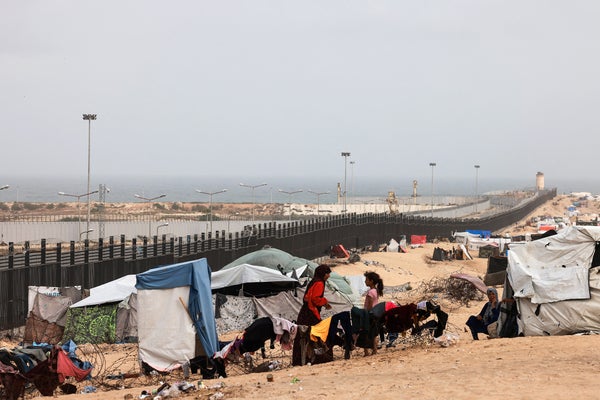April Heat Waves from Gaza to the Philippines Were Made Worse by Climate Change
From Gaza to India to the Philippines, climate change exacerbated often record-breaking extreme heat over the past month
Displaced Palestinians sit outside to escape the searing heat in their camp tents in Rafah in the southern Gaza Strip near the border with Egypt on April 26, 2024.
Mohammed Abed/AFP via Getty Images
Extreme heat has left hundreds of millions of people sweltering in record-breaking temperatures above 40 degrees Celsius (104 degrees Fahrenheit) over the past few weeks across a broad swath of Asia. From the Palestinian territories in the west to India, Thailand and the Philippines to the east, scorching conditions have caused at least dozens of deaths, ruined crops and forced thousands of school closures. Relentless heat waves have worsened the already precarious conditions for those living in refugee camps and in makeshift housing in dense urban areas. And the 1.2 degrees C of warming the world has already experienced has significantly cranked up such events’ severity, a new analysis shows.
That trend of worse and more frequent heat extremes will only continue in these and other places “if you don’t do anything to stop burning fossil fuels,” says the new study’s lead author, Mariam Zachariah, a researcher at the Grantham Institute–Climate Change and the Environment at Imperial College London.
The analysis was conducted by an international team of researchers called World Weather Attribution (WWA), which uses peer-reviewed methods to look for the fingerprints of climate change in extreme weather events. The scientists use trends in historical temperature data, along with computer models, to compare the severity and frequency of extreme events in today’s real-world climate with those in two projected scenarios. One was a simulated world without human-caused climate change, and another was a future under continued warming.
On supporting science journalism
If you’re enjoying this article, consider supporting our award-winning journalism by subscribing. By purchasing a subscription you are helping to ensure the future of impactful stories about the discoveries and ideas shaping our world today.
The group focused on three areas: “West Asia” (the Gaza Strip, the West Bank, Israel, Lebanon, Syria and Jordan), “Southeast Asia” (the Philippines) and “South Asia” (which, in the team’s analysis, included India, Bangladesh, Vietnam…
Click Here to Read the Full Original Article at Scientific American Content: Global…

